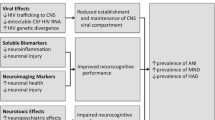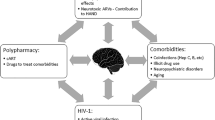Abstract
In the past decade we have seen a milder phenotype and decreased incidence of HIV-1 associated dementia (HAD), largely due to the widespread use of combination chemotherapy to reduce viral burden. However, the prevalence of neurologic disease in people living with HIV-1 has actually increased, raising significant concerns that new therapeutic strategies, directed at restoring neuronal and glial homeostasis and signaling in the central nervous system (CNS), as opposed to directly interfering with the life cycle of HIV-1, must be developed. In this review, we focus briefly on previous Phase 1 clinical trials for adjunctive (i.e., chemotherapeutic agents that do not have a primary antiretroviral mechanism of action) therapy in patients with HAD, followed by an overview of key molecular events in the neuropathogenesis of HAD, and then discuss in more detail our rationale for investigating the effects of therapeutic agents that restore impaired mitochondrial bioenergetics in the CNS. Specifically, we focus on agents that either work in part through K-ATP channels, present in both mitochondria and plasma membranes, and agents that work to weakly uncouple the respiratory capacity of the electron transport chain in mitochondria from ATP production. We propose these agents may be complementary to currently available antiretroviral agents and may significantly improve the capacity of CNS infected with HIV-1 to meet increased bioenergetic demands involved in normal synaptic communication.
Similar content being viewed by others
References
Bonfoco E, D Krainc, M Ankarcrona, P Nicotera and SA Lipton (1995) Apoptosis and necrosis, two distinct events induced, respectively, by mild and intense insults with N-methyl-D-aspartate or nitric oxide/superoxide in cortical cell cultures.Proc. Natl. Acad. Sci. USA92, 7162–7166.
DiCenzo R, D Peterson, K Cruttenden, G Morse, G Riggs, H Gelbard and G Schifitto (2004) Effects of valproic acid coadministration on plasma efavirenz and lopinavir concentrations in human immunodeficiency virus-infected adults.Antimicrob. Agents Chemother. 48, 4328–4331.
Dou H, JD Kingsley, RL Mosley, HA Gelbard and HE Gendelman (2004) Neuroprotective strategies for HIV-1 associated dementia.Neurotoxicity Res. 6, 503–521.
Dugravot S, F Grolleau, D Macherel, A Rochetaing, B Hue, M Stankiewicz, J Huignard and B Lapied (2003) Dimethyl disulfide exerts insecticidal neurotoxicity through mitochondrial dysfunction and activation of insect K(ATP) channels.J. Neurophysiol. 90, 259–270.
Garden GA, SL Budd, E Tsai, L Hanson, M Kaul, DM D’Emilia, RA Friedlander, J Yuan, E Masliah and SA Lipton (2002) Caspase cascades in human immunodeficiency virus-associated neurodegeneration.J. Neurosci. 22, 4015–4024.
Gendelman HE, J Zheng, CL Coulter, A Ghorpade, M Che, M Thylin, R Rubocki, Y Persidsky, F Hahn, J Reinhard Jr and S Swindells (1998) Suppression of inflammatory neurotoxins by highly active antiretroviral therapy in human immunodeficiency virus-associated dementia.J. Infect. Dis. 178, 1000–1007.
Geraci AP and DM Simpson (2001) Neurological manifestations of HIV-1 infection in the HAART era.Compr. Ther. 27, 232–241.
Giulian D, E Wendt, K Vaca and CA Noonan (1993) The envelope glycoprotein of human immunodeficiency virus type 1 stimulates release of neurotoxins from monocytes.Proc. Natl. Acad. Sci. USA 90, 2769–2773.
Hoerter J, MD Gonzalez-Barroso, E Couplan, P Mateo, C Gelly, AM Cassard-Doulcier, P Diolez and F Bouillaud (2004) Mitochondrial uncoupling protein 1 expressed in the heart of transgenic mice protects against ischemic-reperfusion damage.Circulation 110, 528–533.
Kaul M LS (2000) The NMDA receptor — its role in neuronal apoptosis and HIV-associated dementia.Science Online, NeuroAIDS 3, 1
Kaul M and SA Lipton (1999) Chemokines and activated macrophages in HIV gp120-induced neuronal apoptosis.Proc. Natl. Acad. Sci. USA 96, 8212–8216.
Kaul M, GA Garden and SA Lipton (2001) Pathways to neuronal injury and apoptosis in HIV-associated dementia.Nature 410, 988–994.
Lipton SA and HE Gendelman (1995) Seminars in medicine of the Beth Israel Hospital, Boston. Dementia associated with the acquired immunodeficiency syndrome.N. Engl. J. Med. 332, 934–940.
Lipton SA and PA Rosenberg (1994) Excitatory amino acids as a final common pathway for neurologic disorders.N. Engl. J. Med. 330, 613–622.
Maragos WF and AS Korde (2004) Mitochondrial uncoupling as a potential therapeutic target in acute central nervous system injury.J. Neurochem. 91, 257–262.
Matarrese P, L Gambardella, A Cassone, S Vella, R Cauda and W Malorni (2003) Mitochondrial membrane hyperpolarization hijacks activated T lymphocytes toward the apoptotic-prone phenotype, homeostatic mechanisms of HIV protease inhibitors.J. Immunol. 170, 6006–6015.
Mattiasson G, M Shamloo, G Gido, K Mathi, G Tomasevic, S Yi, CH Warden, RF Castilho, T Melcher, M Gonzalez-Zulueta, K Nikolich and T Wieloch (2003) Uncoupling protein-2 prevents neuronal death and diminishes brain dysfunction after stroke and brain trauma.Nat. Med. 9, 1062–1068.
Neuenburg JK, HR Brodt, BG Herndier, M Bickel, P Bacchetti, RW Price, RM Grant and W Schlote (2002) HIV-related neuropathology, 1985 to 1999, rising prevalence of HIV encephalopathy in the era of highly active antiretroviral therapy.J. Acquir. Immune Defic. Syndr. 31, 171–177.
Perry SW, JP Norman, A Litzburg, D Zhang, S Dewhurs and HA Gelbard (2005) HIV-1 transactivator of transcription protein induces mitochondrial hyperpolarization and synaptic stress leading to apoptosis.J. Immunol. 174, 4333–4344.
Petito CK and B Roberts (1995) Evidence of apoptotic cell death in HIV encephalitis.Am. J. Pathol. 146, 1121–1130.
Poppe M, C Reimertz, H Dussmann, AJ Krohn, CM Luetjens, D Bockelmann, AL Nieminen, D Kogel and JH Prehn (2001) Dissipation of potassium and proton gradients inhibits mitochondrial hyperpolarization and cytochrome c release during neural apoptosis.J. Neurosci. 21, 4551–4563.
Sacktor N (2002) The epidemiology of human immunodeficiency virus-associated neurological disease in the era of highly active antiretroviral therapy.J. Neurovirol. 8 Suppl. 2, 115–121.
Smith PA, P Proks and A Moorhouse (1999) Direct effects of tolbutamide on mitochondrial function, intracellular Ca2+ and exocytosis in pancreatic beta-cells.Pflugers Arch. 437, 577–588.
Strahlendorf J, C Box, J Attridge, J Diertien, V Finckbone, WM Henne, MS Medina, R Miles, S Oomman, M Schneider, H Singh, M Veliyaparambil and H Strahlendorf (2003) AMPAinduced dark cell degeneration of cerebellar Purkinje neurons involves activation of caspases and apparent mitochondrial dysfunction.Brain Res. 994, 146–159.
Welch K and A Morse (2002) The clinical profile of end-stage AIDS in the era of highly active antiretroviral therapy.AIDS Patient Care STDS 16, 75–81.
Yoshida T, T Umekawa, K Kumamoto, N Sakane, A Kogure, M Kondo, Y Wakabayashi, T Kawada, I Nagase and M Saito (1998) beta 3-Adrenergic agonist induces a functionally active uncoupling protein in fat and slow-twitch muscle fibers.Am. J. Physiol. 274, E469-E475.
Author information
Authors and Affiliations
Corresponding author
Rights and permissions
About this article
Cite this article
Perry, S.W., Norman, J.P. & Gelbard, H.A. Adjunctive therapies for HIV-1 associated neurologic disease. neurotox res 8, 161–166 (2005). https://doi.org/10.1007/BF03033827
Received:
Accepted:
Issue Date:
DOI: https://doi.org/10.1007/BF03033827




